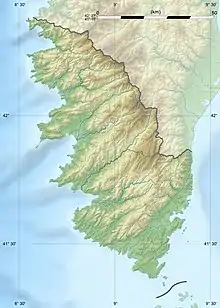Corse-du-Sud
Corse-du-Sud (French pronunciation: [kɔʁs dy syd] ⓘ; Corsican: Corsica suttana [ˈkorsiga sutˈtana], Pumonte [puˈmɔntɛ][lower-alpha 1] or Pumonti [puˈmɔnti]; English: Southern Corsica) is (as of 2019) an administrative department of France, consisting of the southern part of the island of Corsica. The corresponding departmental territorial collectivity merged with that of Haute-Corse on 1 January 2018, forming the single territorial collectivity of Corsica, with territorial elections coinciding with the dissolution of the separate council.[3] Although its administrative powers were ceded to the new territorial collectivity, it continues to remain an administrative department in its own right. In 2019, it had a population of 158,507.[4]
Corse-du-Sud
Southern Corsica | |
|---|---|
| Pumonte | |
 Coat of arms | |
 Location of Corse-du-Sud in France | |
| Coordinates: 41°51′N 9°2′E | |
| Country | France |
| Region | Corsica |
| Prefecture | Ajaccio |
| Subprefectures | Sartène |
| Government | |
| • Prefect | Amaury de Saint-Quentin[1] |
| Area | |
| • Total | 4,014 km2 (1,550 sq mi) |
| Population | |
| • Total | 160,814 |
| • Rank | 96th |
| • Density | 40/km2 (100/sq mi) |
| Time zone | UTC+1 (CET) |
| • Summer (DST) | UTC+2 (CEST) |
| Department number | 2A |
| Arrondissements | 2 |
| Cantons | 11 |
| Communes | 124 |
| ^1 French Land Register data, which exclude estuaries, and lakes, ponds, and glaciers larger than 1 km2 | |
History

The department was formed on 1 January 1976, when the single department of Corsica was divided into Haute-Corse and Corse-du-Sud. Its boundaries corresponded to the former department of Liamone, which existed from 1793 to 1811.
On 6 February 1998, Corse-du-Sud's prefect Claude Érignac was assassinated in Ajaccio. The Corsican nationalist Yvan Colonna was eventually convicted of the crime.
On 6 July 2003 a referendum rejected increased autonomy by a small majority, with 50.98 percent voting against and 49.02 percent for. This was a major setback for the French Minister of the Interior, Nicolas Sarkozy, who had hoped to use Corsica as the first step in his decentralization programme.
On 1 January 2018, Corse-du-Sud's administrative powers were partly ceded to the new territorial collectivity of Corsica.[3]
Geography
The department is surrounded on three sides by the Mediterranean Sea and on the north by the department of Haute-Corse. The entire island of Corsica is mountainous with many beautiful beaches.
Principal towns
The most populous commune is Ajaccio, the prefecture. As of 2019, there are 3 communes with more than 4,000 inhabitants:[4]
| Commune | Population (2019) |
|---|---|
| Ajaccio | 71,361 |
| Porto-Vecchio | 11,132 |
| Bastelicaccia | 4,124 |
Demographics
The people living in Corse-du-Sud are called Suttanacci.
| Year | Pop. | ±% p.a. |
|---|---|---|
| 1968 | 89,566 | — |
| 1975 | 100,278 | +1.63% |
| 1982 | 108,604 | +1.15% |
| 1990 | 118,808 | +1.13% |
| 1999 | 118,593 | −0.02% |
| 2007 | 139,362 | +2.04% |
| 2012 | 145,429 | +0.86% |
| 2017 | 157,249 | +1.58% |
| Source: INSEE[5] | ||
According to an INSEE study, in the period 2020-2021 9.1% of the population were immigrants and 11.3% were descendants of immigrants (at least one parent).
Politics
The current prefect of Corse-du-Sud (and also prefect of the collectivity of Corsica) is Amaury de Saint-Quentin, who took office on 7 March 2022.[1]
Current National Assembly representatives
| Constituency | Member[6] | Party | |
|---|---|---|---|
| Corse-du-Sud's 1st constituency | Jean-Jacques Ferrara | The Republicans | |
| Corse-du-Sud's 2nd constituency | Paul-André Colombani | Pè a Corsica | |
Tourism
The former department enjoys the mild and hot climate of Mediterranean Islands, and therefore attracts a lot of tourists. Its perhaps largest tourist attraction is the city of Bonifacio, part of which is built upon a huge cliff. But inside mountains are beautiful as well, especially the Aiguilles de Bavella, some naked, needle-like rocks.
Notes
- Also Italian: [puˈmonte].
See also
References
- "Corse : prise de fonctions du préfet Amaury de Saint-Quentin qui assure vouloir "rétablir le dialogue"". France 3. 7 March 2022.
- "Téléchargement du fichier d'ensemble des populations légales en 2020". The National Institute of Statistics and Economic Studies. 29 December 2022.
- Morgane Rubetti (1 December 2017). "Corse : cinq questions pour comprendre les élections territoriales". Le Figaro. Retrieved 2 December 2017.
- Populations légales 2019: 2A Corse-du-Sud, INSEE
- Population en historique depuis 1968, INSEE
- Nationale, Assemblée. "Assemblée nationale ~ Les députés, le vote de la loi, le Parlement français". Assemblée nationale.




